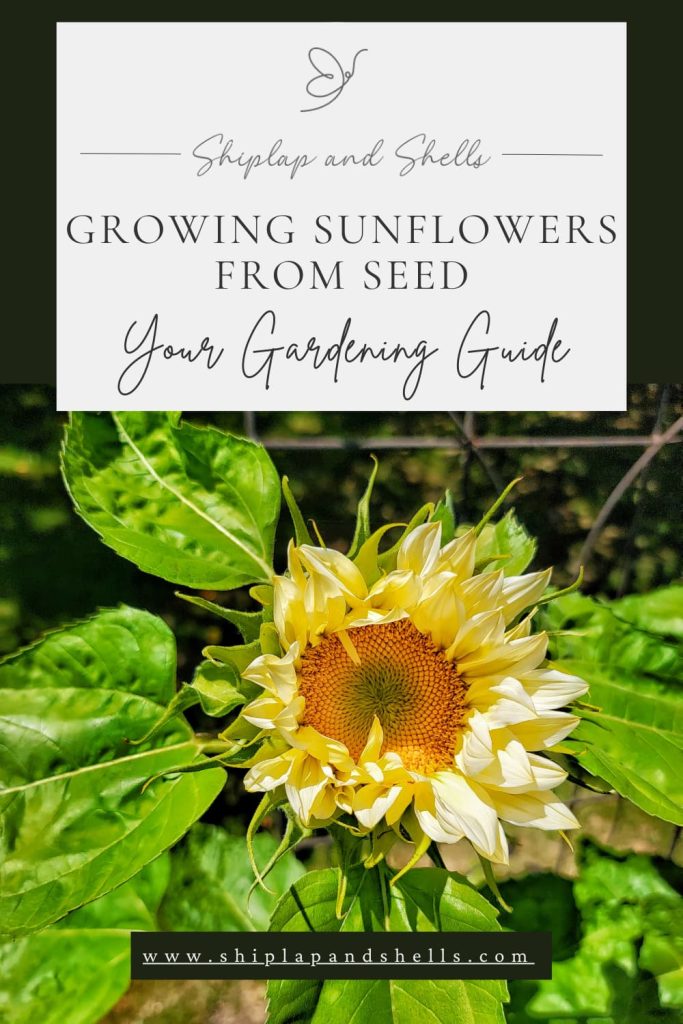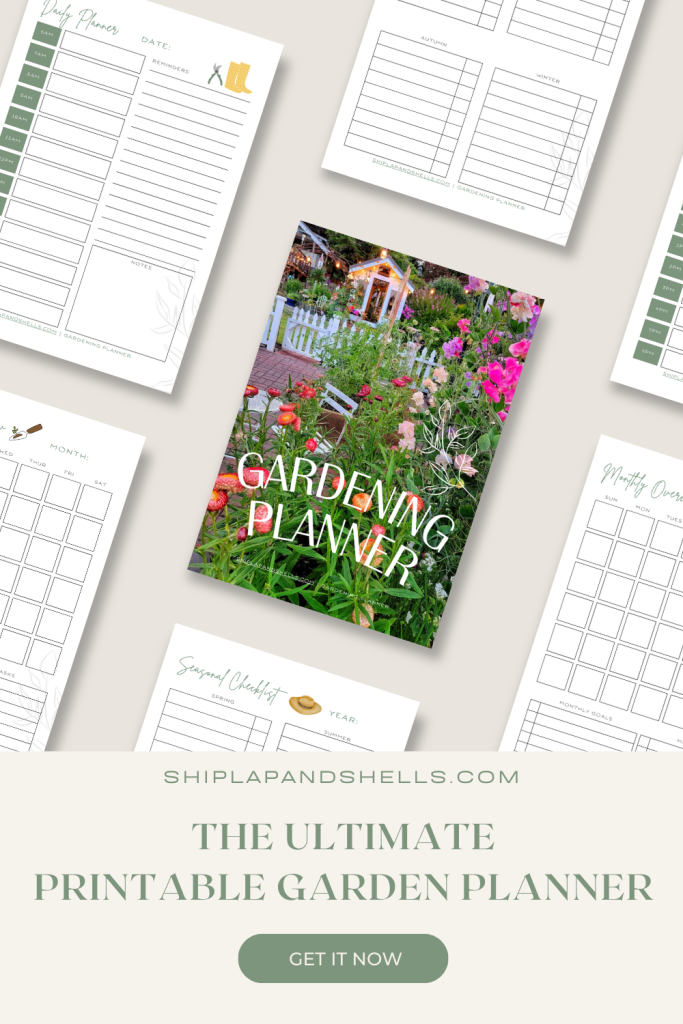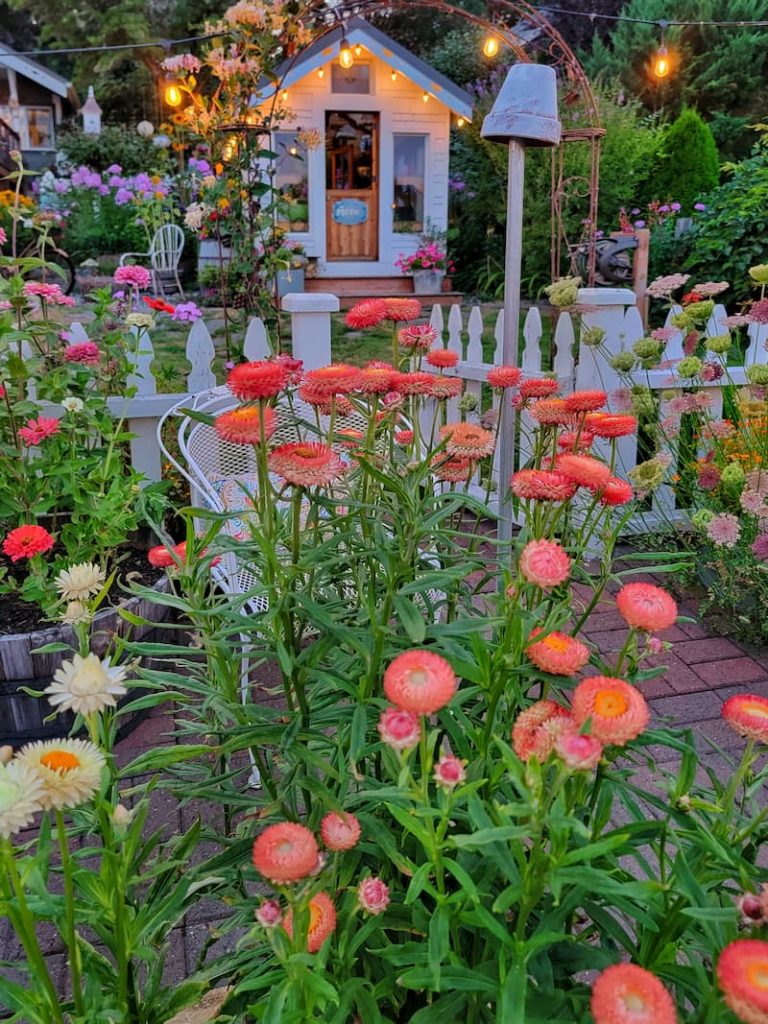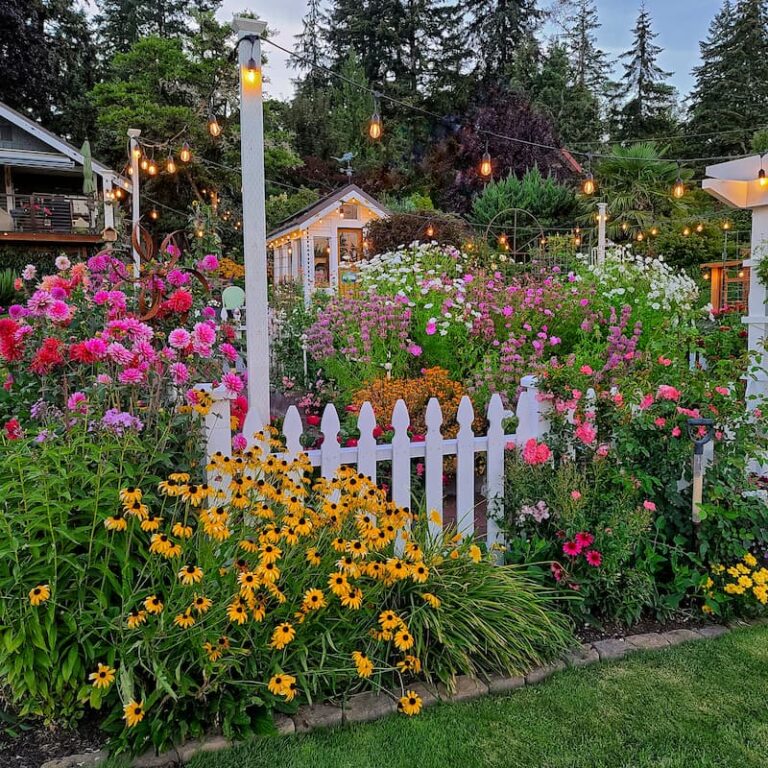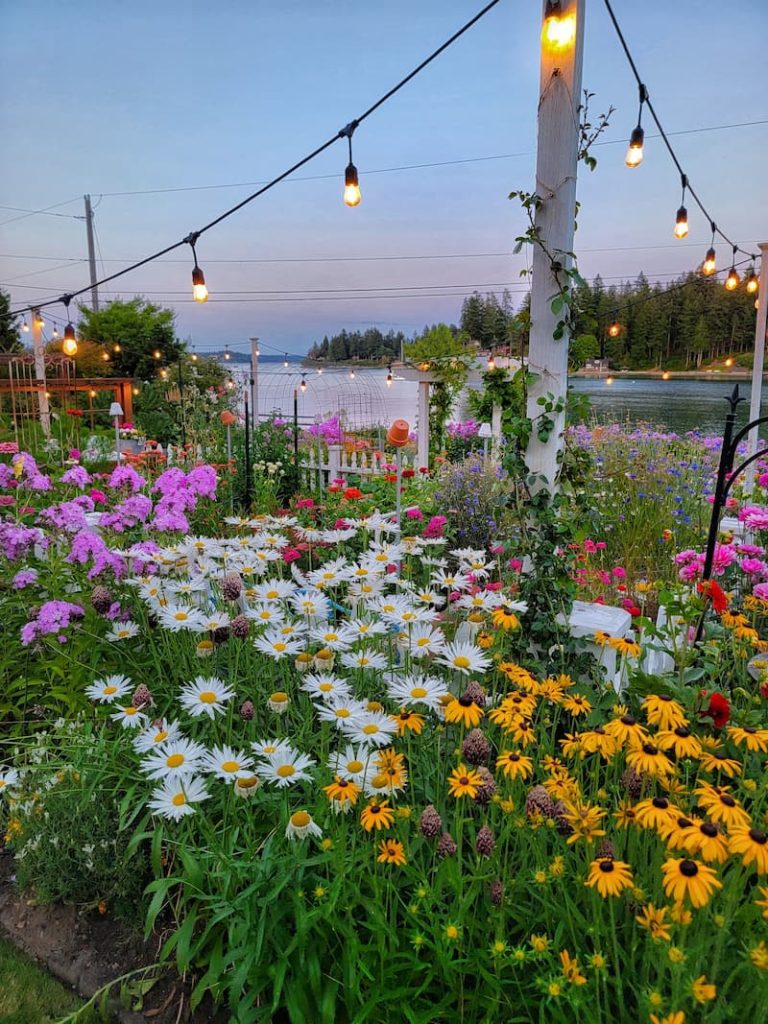Growing Sunflowers from Seed: A Complete Guide
Are you thinking of growing sunflowers from seed for the summer garden? This guide will teach you everything you need to know about bright and beautiful sunflowers, from selecting the perfect varieties to planting, nurturing, and harvesting them.
Few flowers capture the spirit of summer quite like these majestic tall plants. With their towering stems and cheerful flower heads, sunflowers bring warmth and joy to any garden.
There are many great reasons to grow sunflowers, whether you’re looking to create a stunning sunflower patch for cut flowers or want to enjoy their beauty in a cottage-style or vegetable garden.
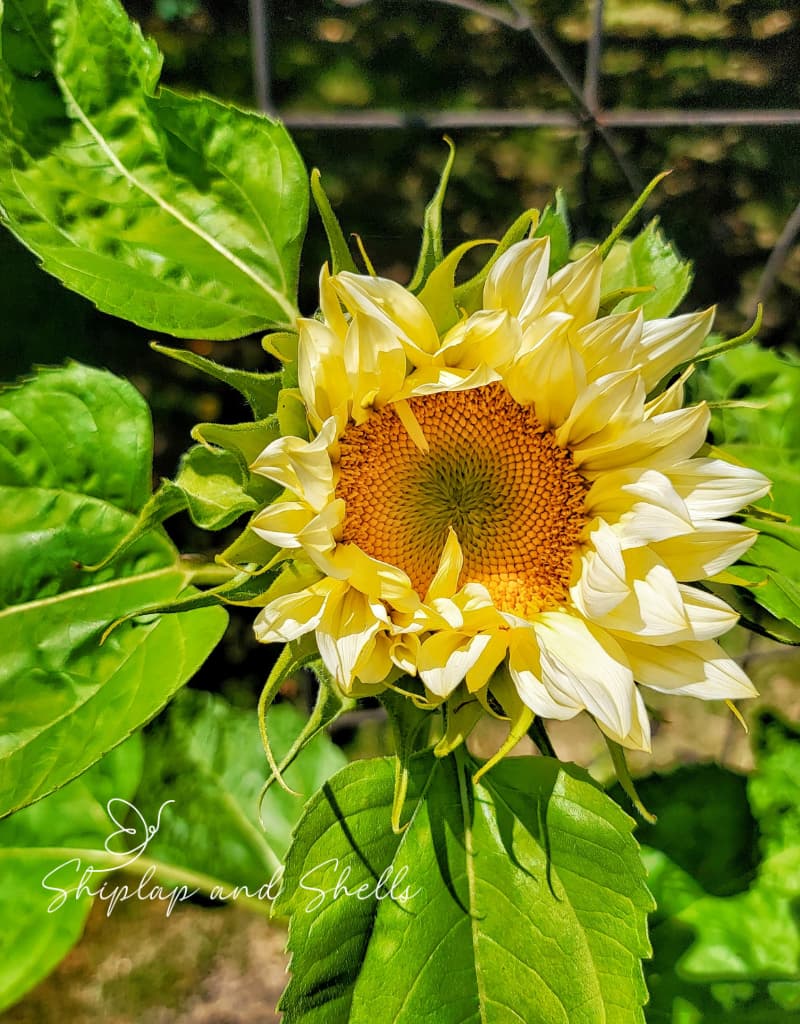
As an Amazon affiliate, I earn from qualifying purchases at no extra cost to you. My blog contains other affiliate links for your convenience as well. Click here to read my privacy policy.
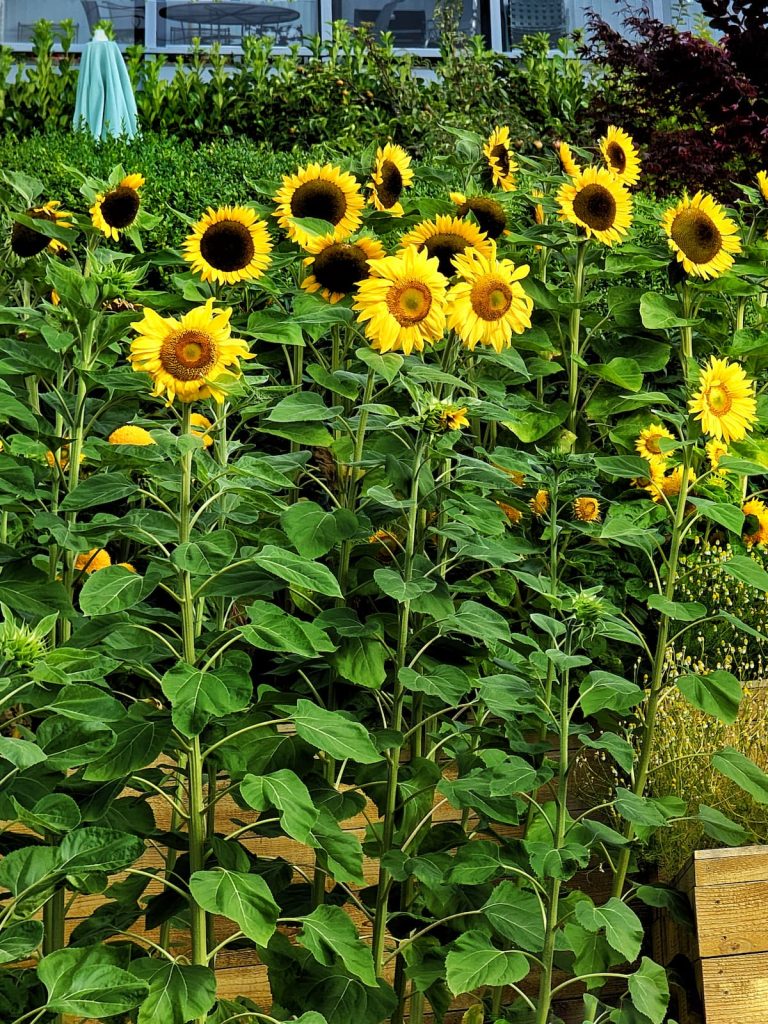
About Sunflowers
Sunflower plants (botanical name: Helianthus annuus) are stunning summer flowers with unmistakable golden blooms and towering stems.
Depending on the variety, the upright stem with short, coarse hairs can grow several feet high, hold a single flower, or be branched with several blooms.
| USDA Hardiness Zones | 2-11 |
| Typical Bloom Time | mid-summer into early fall |
| When to Plant | after the last frost once the garden soil is at least 55°F. |
| Colors | Yellow, mahogany, red, bicolor |
To ensure sunflowers grow well in your area, you can find your USDA hardiness zone here if you’re unsure. Your area’s average last frost date can be found here.
The guide below explains more about sunflowers, including whether they’re annuals or perennials, how long they bloom, their impressive heights, and the best varieties to grow from seed.
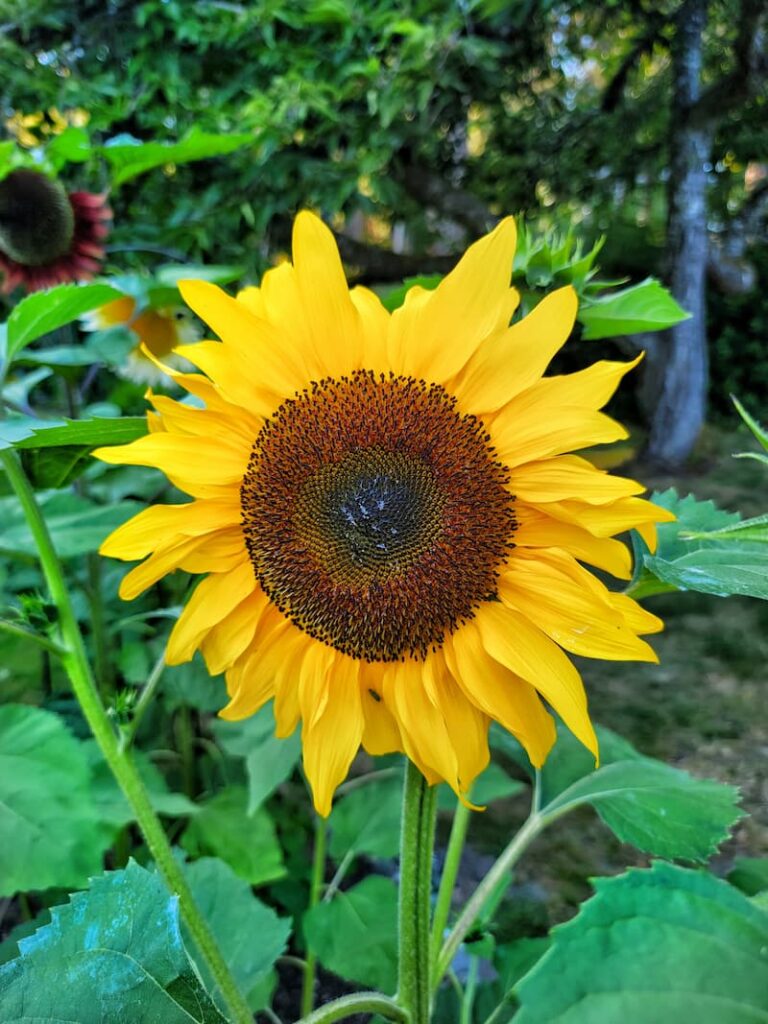
Are Sunflowers Annuals or Perennials?
Sunflowers can be either annual or perennial, depending on the variety.
Annual sunflowers are the most commonly grown. They complete their entire life cycle in one growing season, from seed to bloom to seed again.
Perennial sunflowers, such as Helianthus maximiliani and Helianthus multiflorus, return yearly with the proper care. While they may not grow as tall or produce as large flower heads as an annual plant, perennials add lasting charm to your garden.
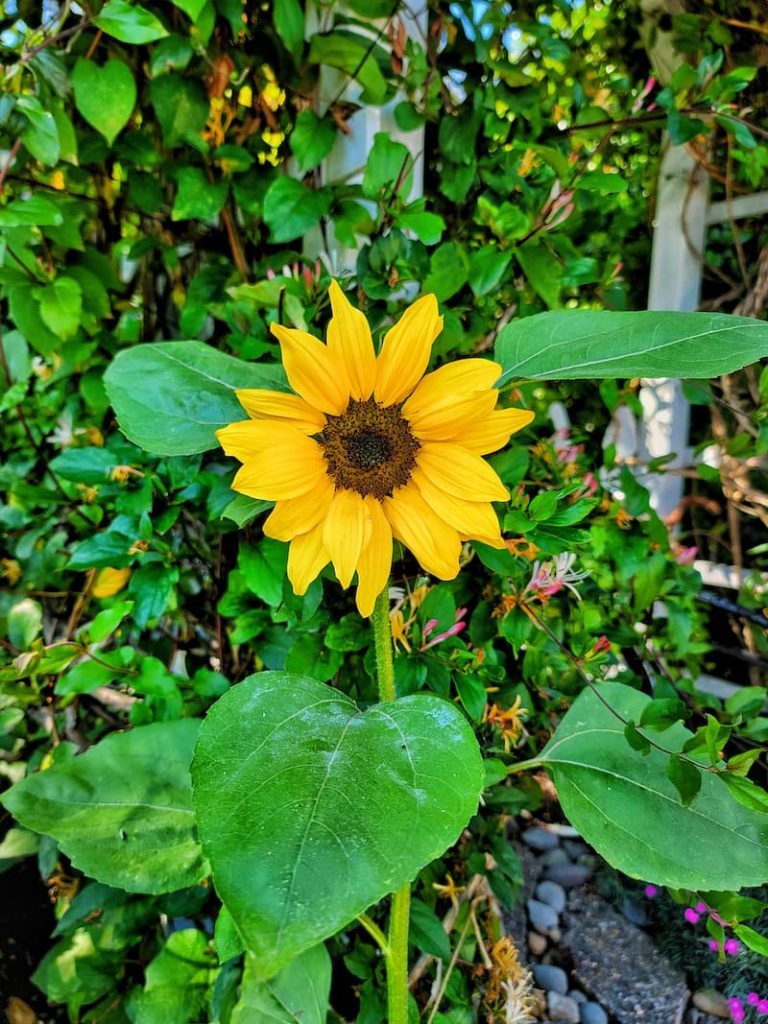
How Long Do Sunflowers Take to Bloom?
The time it takes for sunflowers to bloom depends on the variety and growing conditions.
Generally, annual sunflowers take between 70 and 100 days from planting to flowering. Some dwarf varieties, such as Teddy Bear or Sunspot, can bloom in as little as 60 days, while giant sunflowers, like Mammoth, may require closer to 90 to 100 days to reach full height.
Perennial sunflowers, on the other hand, may take longer to establish but will bloom in the late summer to early fall. Regardless of the type, your sunflowers should get plenty of sunlight and consistent watering for timely and vibrant blooms.
Garden Supplies and Tools
Check out my favorite garden supplies and tools for the growing season. Whether you’re looking for potting soil or deer repellent, you’ll find what I use in my own garden.
How Tall Do They Get?
With the right care and sunlight, sunflowers of all sizes can flourish beautifully in your garden.
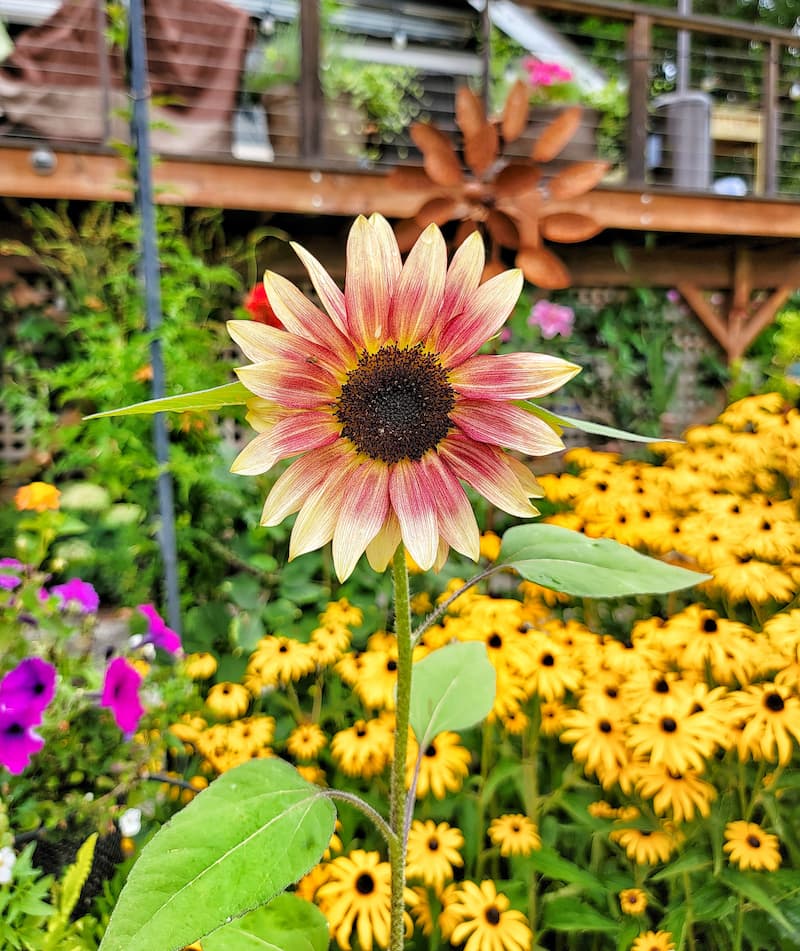
Best Sunflower Varieties to Grow from Seed
Plenty of great options exist when choosing the varieties of sunflowers to grow from seed.
For tall varieties, Mammoth and Russian Giant are favorites. They reach heights of up to 15 feet and have large blooms perfect for creating a dramatic statement in the garden.
If vivid colors and branching stems are on your wishlist, try Autumn Beauty with warm gold, bronze, and mahogany hues or Velvet Queen with deep burgundy petals.
For smaller gardens or container planting, dwarf varieties like Teddy Bear, Sunspot, and Little Becka provide compact sizes with just as much beauty.
Perennial varieties, such as Helianthus maximiliani or Helianthus multiflorus Lemon Queen, are ideal for gardeners wanting to grow sunflowers that will return the following year.
I personally love the Pro Cut White Lite and Red Pro Cut sunflower varieties.
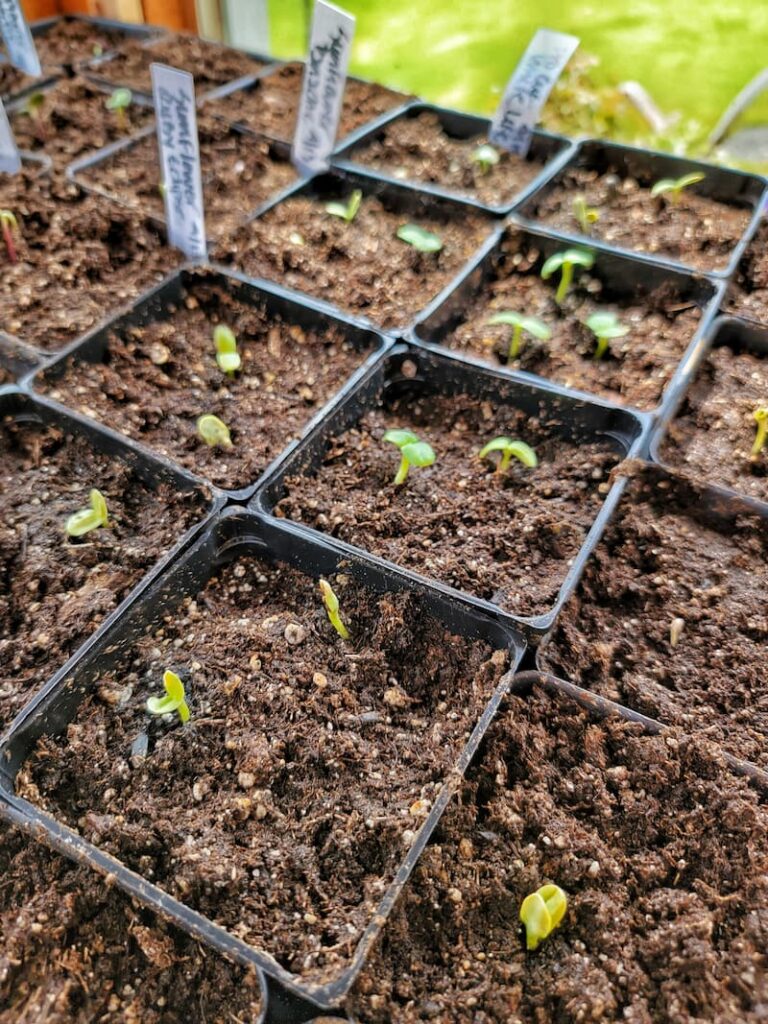
How to Grow Sunflowers from Seed
We’ve got you covered when it comes to sowing, nurturing, and harvesting sunflowers. You’ll learn essential tips and tricks to ensure your sunflowers thrive and provide a gorgeous garden display all season long.
Germinating Sunflower Seeds Indoors
Starting sunflower seeds indoors is a great way to get a head start on the growing season, especially in cooler climates. I choose to sow seeds in my greenhouse to protect them from the birds eating the seeds in the early stages of growth.
Fill biodegradable peat pots with a high-quality seed-starting mix to germinate sunflower seeds indoors. Sow the seeds about 1 inch deep and lightly cover them with soil.
Bottom water gently to moisten the soil, then place the pots in a warm location with plenty of sunlight or under grow lights. Cover the pots with a clear plastic lid or plastic wrap to maintain consistent humidity and warmth. Within 7 to 10 days, you should see tiny green shoots emerging as the seeds germinate.
Once the seedlings have developed their first true leaves and the outdoor soil has warmed up, gradually acclimate them to outdoor conditions before transplanting them into your garden. This early start will give your sunflowers a strong foundation for healthy growth and vibrant blooms.
Prepping Sunflower Seeds for Planting
Prepping sunflower seeds for planting helps them have the best chance of germinating and growing into healthy plants.
Start by selecting high-quality seeds from reliable sources and discarding damaged or discolored ones.
If you’re using seeds saved from previous seasons, you can quickly test their viability by soaking them in water for a few hours: viable seeds will sink, while those that float may not germinate.
Consider soaking your seeds overnight in water to soften the seed coat and encourage quicker germination. You can scarify the seeds by gently rubbing them with sandpaper to thin the outer layer.
Once prepped, your sunflower seeds can be planted directly outdoors or started indoors for an early jump on the growing season.
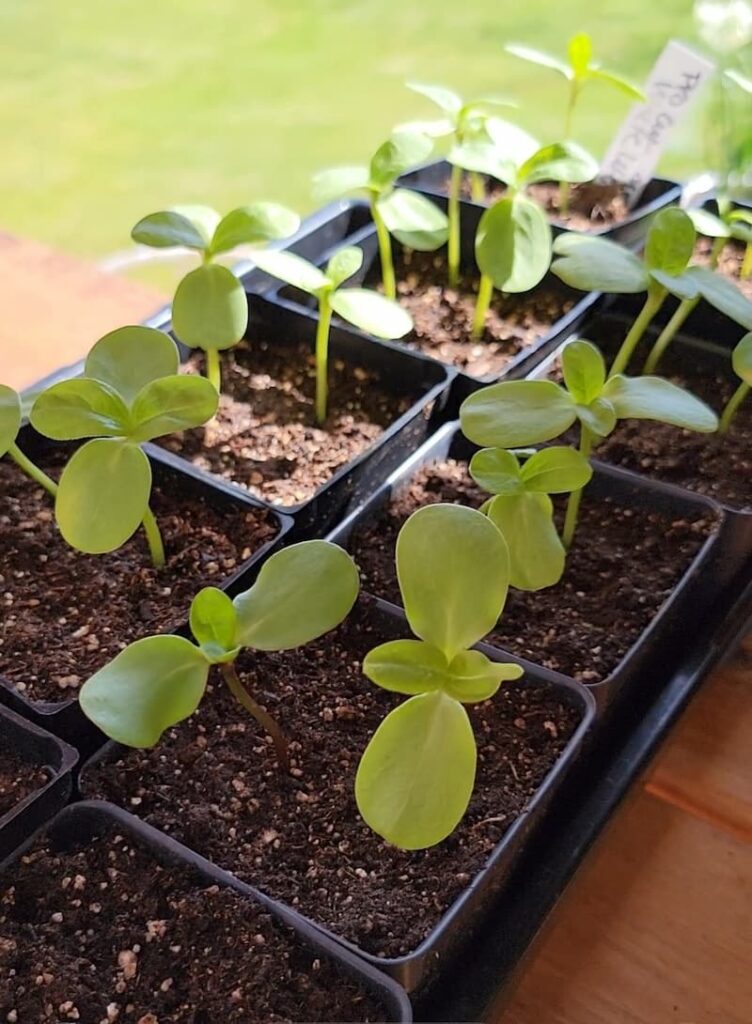
Best Soil for Growing Sunflowers from Seed
Understanding your soil’s composition and pH level is essential to know what nutrients your plants need.
Start by purchasing a simple soil test kit or sending a sample to a local extension service for analysis.
If you decide to use a kit, follow the test kit instructions or send the sample to the lab. You’ll receive a report indicating the soil’s pH and nutrient levels. From there, you can amend your soil with the appropriate fertilizers or compost to ensure your plants thrive.
Sunflowers thrive in nutrient-rich, well-draining soil with a pH range of 6.0 to 7.5.
Before planting, prepare the soil by loosening it to a depth of 12-15 inches to accommodate their deep root systems. Amend the soil with compost or well-rotted manure to boost fertility and organic matter.
Sandy loam is ideal for sunflowers, providing good drainage while retaining enough moisture to support vigorous growth. If your soil is heavy clay or too sandy, improve its texture by mixing in compost or other organic matter.
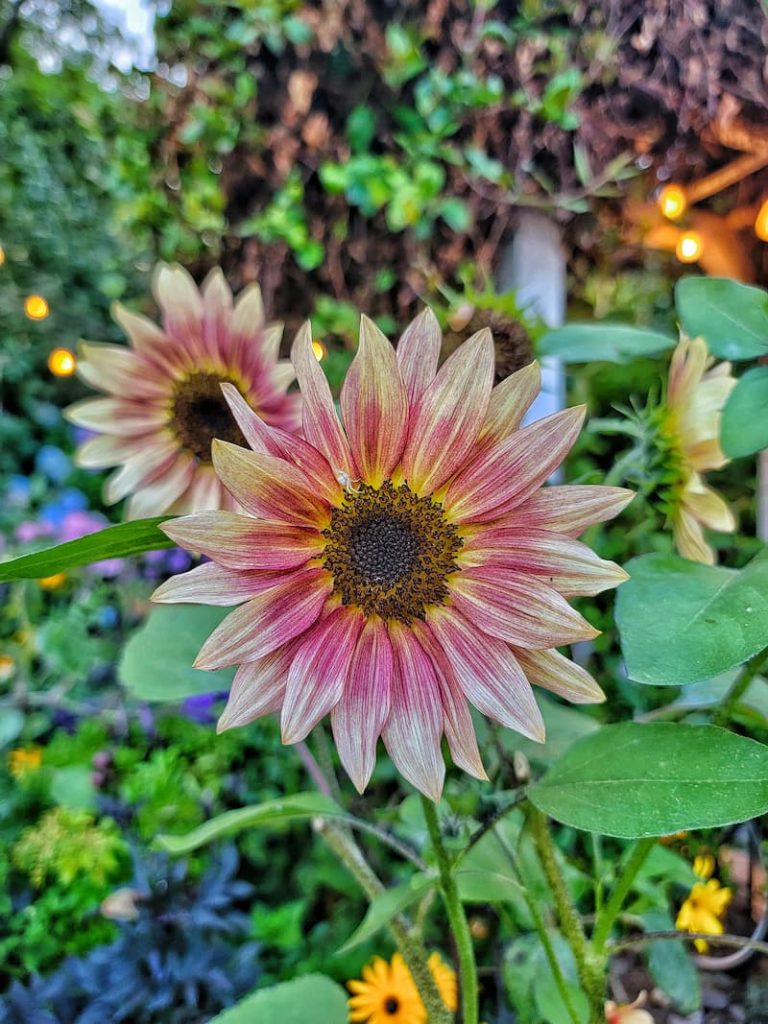
What is the Best Fertilizer for Sunflowers?
Sunflowers are heavy feeders, so providing them with the right nutrients is crucial for strong growth and vibrant blooms. The best fertilizer for sunflowers is one that contains a balanced ratio of nitrogen (N), phosphorus (P), and potassium (K), such as a 10-10-10 or 5-5-5 formula.
During the growing season, side-dress the plants with a slow-release granular fertilizer when the seedlings are 6 inches tall and again just before they flower. If you prefer liquid fertilizers, apply a diluted solution every 2-4 weeks.
Be careful not to over-fertilize with nitrogen, as this can lead to excessive foliage growth at the expense of flower production. Instead, ensure your sunflowers receive adequate phosphorus and potassium to encourage strong stems and large, healthy blooms.
Do Sunflowers Like Full Sun or Shade?
Sunflowers, true to their name, are sun-loving plants that thrive in full sun. They require at least 6-8 hours of direct sunlight daily to grow tall and produce the most gorgeous flower heads.
Full sun encourages strong stems, vibrant flowers, and optimal seed development. Without sufficient sunlight, sunflowers may become leggy and produce smaller blooms.
Seed Starting Supplies
Check out my favorite supplies and tools for starting seeds indoors. Whether you’re looking for grow lights or a seed starting mix, you’ll find what I use in my own greenhouse.
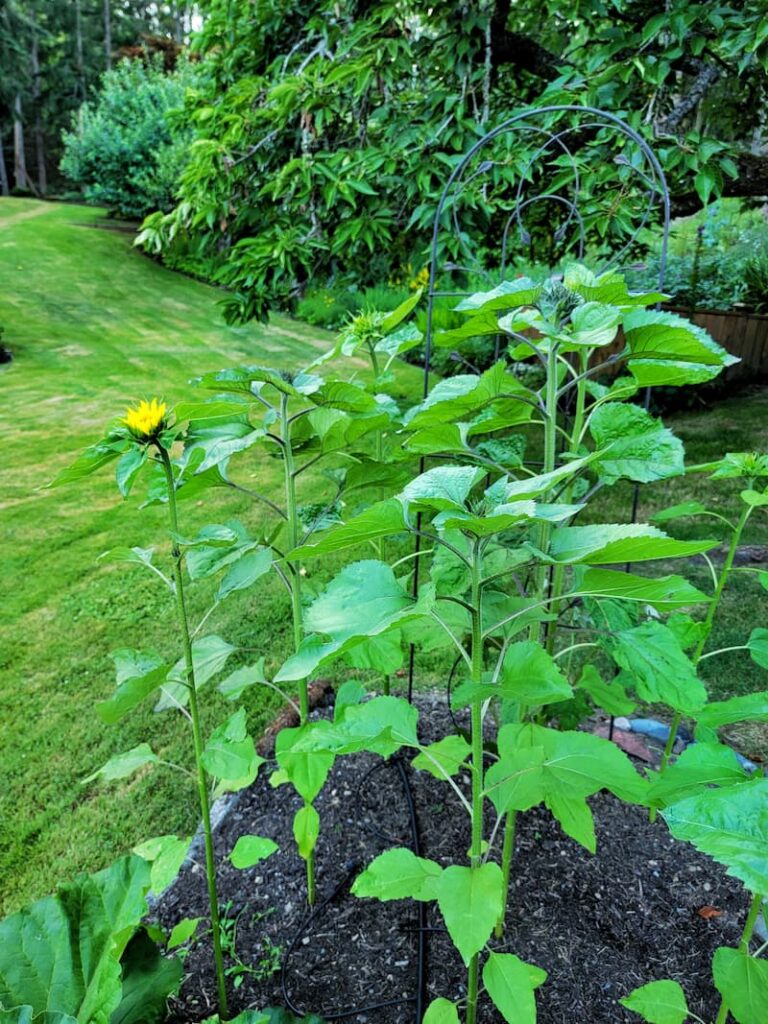
Planting Sunflower Seeds Outdoors
Sunflowers are resilient flowers that thrive when sown directly into well-prepared soil, establishing strong root systems right from the start.
This section will guide you through the best time to plant, choosing the perfect location, and preparing the soil to ensure your sunflower seeds will have the ideal conditions to flourish in the garden.
When is the Best Time to Plant Sunflower Seeds?
The best time to plant sunflower seeds is after the danger of frost has passed and the soil has warmed to at least 50-60°F (10-15°C). This is typically in most regions in late spring, around April to May.
Sunflowers are heat-loving plants that thrive in warm weather, so planting them too early can slow germination and growth. If you live in a cooler climate or want a head start, you can sow sunflowers indoors about 2-3 weeks before the last frost date and transplant the young seedlings outdoors once the soil is warm enough.
For continuous blooms throughout the summer, consider succession planting by staggering your planting every 2-3 weeks until mid-July.
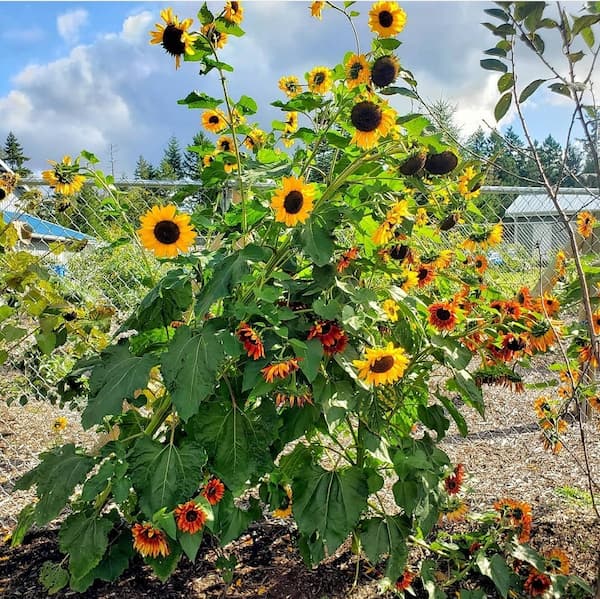
How to Plant Sunflowers
Planting sunflowers is straightforward whether you’re sowing seeds directly in the garden or starting them indoors.
To plant sunflower seeds outdoors, choose a sunny location with well-draining soil and prepare it by loosening it to 12-15 inches deep.
Sow the seeds about 1 inch deep and 6 inches apart for smaller varieties or up to 12 inches apart for larger ones. If planting in rows, space the rows about 2-3 feet apart.
Cover the seeds with soil and gently water the area to keep it evenly moist but not waterlogged.
What Not to Plant With Sunflowers
While sunflowers make a stunning addition to any garden, they can inhibit the growth of certain plants due to a natural compound called allelopathy. This compound, exuded from the sunflower’s roots, leaves, and stems, can prevent some neighboring plants from thriving.
Avoid planting sunflowers near crops like potatoes, pole beans, and bush beans, as they are particularly sensitive to this compound.
Due to their height, sunflowers can cast a significant shadow, potentially shading out sun-loving plants like tomatoes and peppers.
Plant sunflowers at a distance from these sensitive crops or grow them on the north side of your garden bed to minimize shading effects.
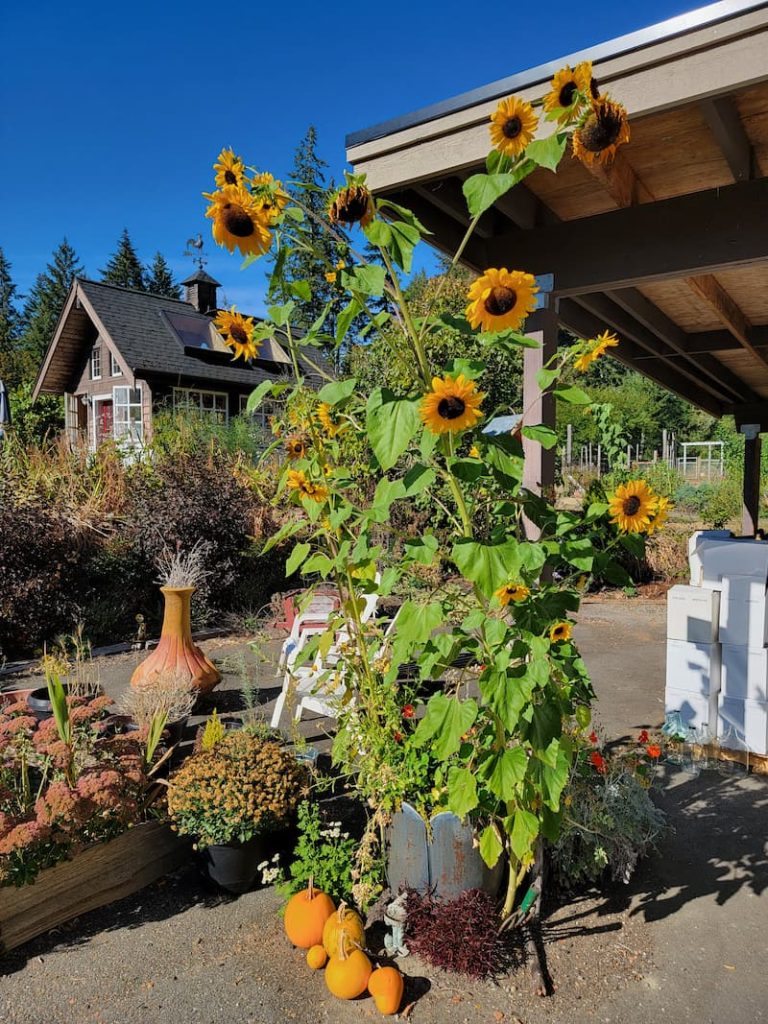
Can You Grow Sunflowers in Containers?
Yes, you can grow sunflowers by seed in containers, and it’s a great option for gardeners with limited space or those wanting to add a splash of color to patios and balconies.
Choose dwarf or medium-sized varieties, such as Teddy Bear, Sunspot, or Little Becka, which typically reach heights between 2 and 4 feet.
Select a container 12-18 inches in diameter and 12 inches deep to accommodate the sunflower’s root system. Ensure the pot has drainage holes and fill it with a high-quality potting mix.
Sow the seeds directly into the container about 1 inch deep, spacing them according to the variety’s mature size.
Place the container in a sunny location where the plants can receive at least 6-8 hours of sunlight daily. Regular watering will keep the soil evenly moist but not waterlogged.
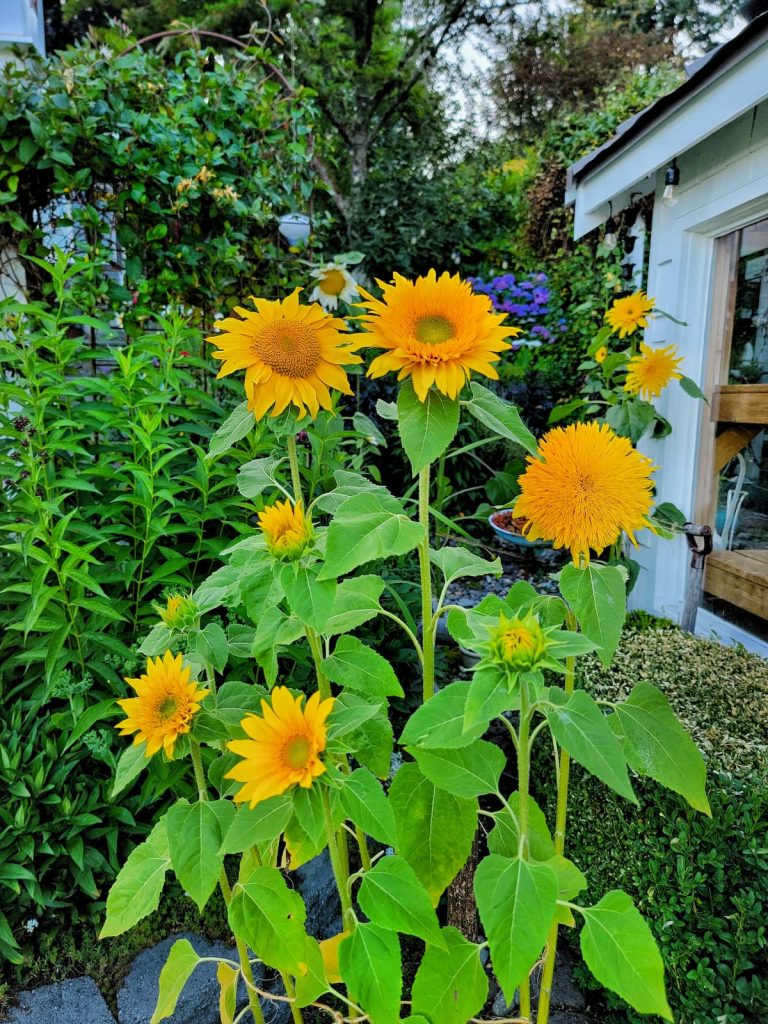
Sunflower Care Guide
Once your sunflowers have grown tall and bloomed, your job is to keep them thriving and healthy throughout the season.
This guide will help you keep your sunflowers in top shape for the growing season, from watering and fertilizing to staking and pest management.
Watering Sunflowers
Sunflowers are relatively drought-tolerant once established, but consistent watering is crucial during their early growth stages.
Water newly planted seeds and seedlings regularly to keep the soil evenly moist and ensure strong root development. Once your sunflowers are bigger and blooming, deep watering once a week is generally sufficient, depending on rainfall and soil type. Try to provide at least 1 inch of water per week, but increase this to 2 inches during hot or dry spells.
Water at the base of the plant to avoid wetting the foliage, which can lead to fungal disease. Mulching around the base will help retain soil moisture and keep the roots cool.
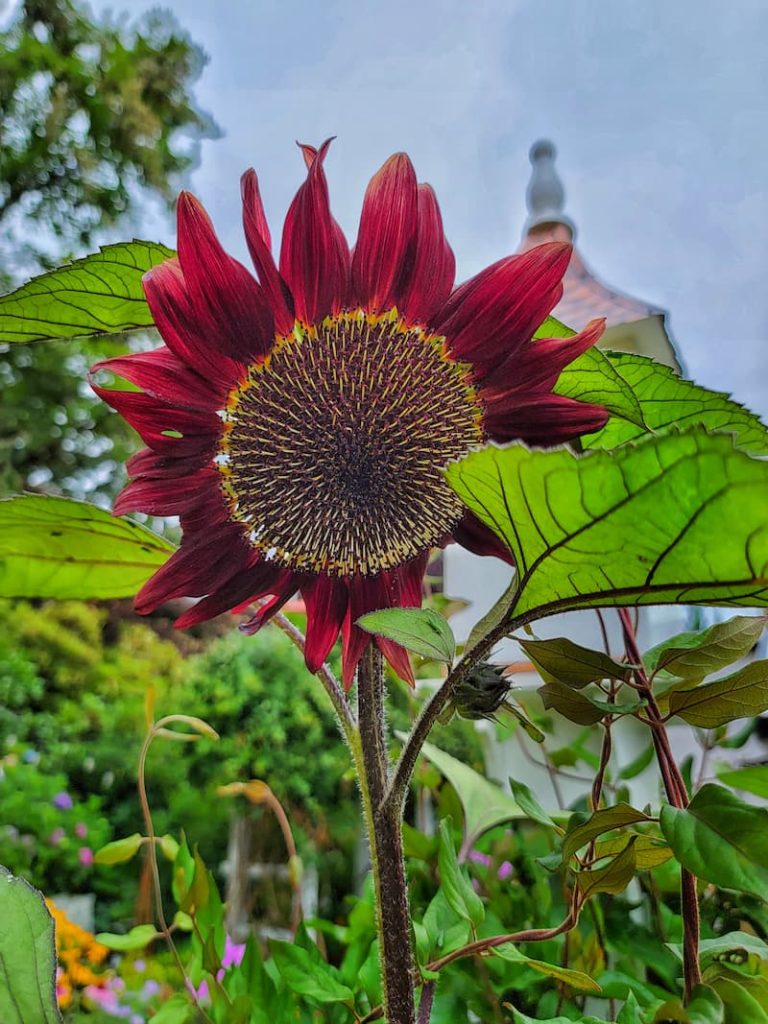
Staking
Staking sunflowers will keep them from toppling over in strong winds or heavy rain.
Begin staking early while the plants are still young and easier to handle. Choose support like bamboo stakes, trellis, or a cane at least 6 feet tall and drive it into the ground about 6 inches from the plant’s base.
As the sunflower grows, gently tie the stem to the stake using soft garden twine. Secure the plant to the stake at intervals of about every 12 inches, ensuring the ties are loose enough to allow for natural growth.
Consider adding multiple stakes or creating a support frame for an extra-large or multi-branching sunflower.
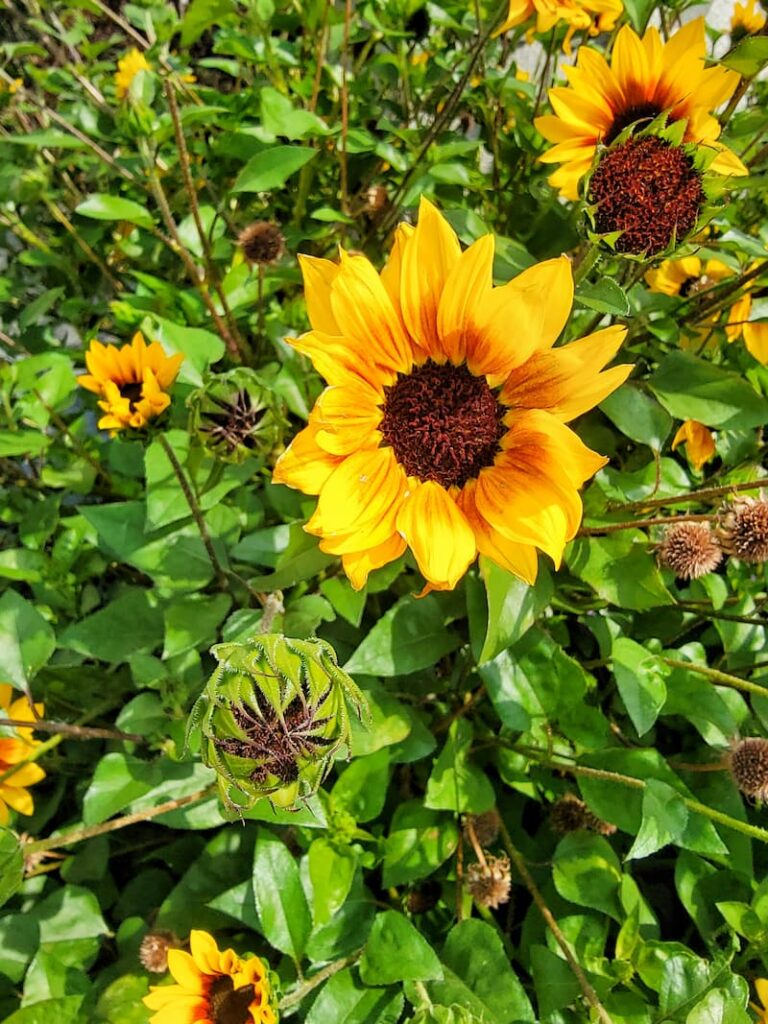
Deadheading
Deadheading sunflowers is an effective way to encourage continuous blooming and maintain a tidy garden appearance.
Once a sunflower bloom begins to fade and lose its vibrant color, it’s time to remove it. Using clean, sharp garden shears, snip off the spent flower head just above the first set of healthy leaves or branching points.
This directs the plant’s energy toward producing new blooms rather than seeds, especially in branching sunflower varieties like Autumn Beauty and Velvet Queen.
For a single stem sunflower, deadheading won’t produce new flowers, but it will help keep the garden tidy and prevent unwanted reseeding.
After the last round of blooms, you can leave the final flower heads to mature fully, providing edible seeds as a natural food source for birds or harvesting seeds for next year’s planting.
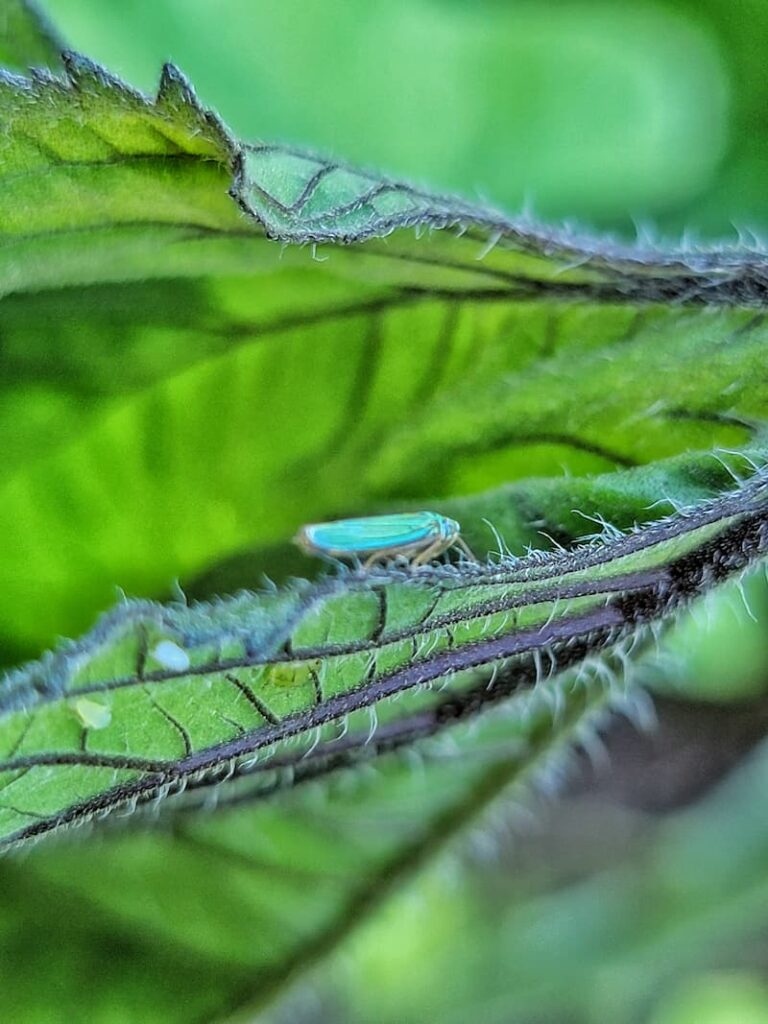
Common Pests
While generally hardy, sunflowers can be susceptible to certain pests and diseases.
Aphids
Among the most common pests are aphids, which cluster on the stems and undersides of leaves, sucking sap and causing wilting.
To control aphids, use insecticidal soap or encourage natural predators like ladybugs.
Beetles and Leafhoppers
Sunflower beetles and leafhoppers can also cause damage by chewing holes in leaves. Hand-pick beetles or use neem oil to deter them.
Birds and Squirrels
Birds and squirrels can also be problematic, especially when seeds are maturing. Protect sunflower heads with mesh bags or netting to deter them.
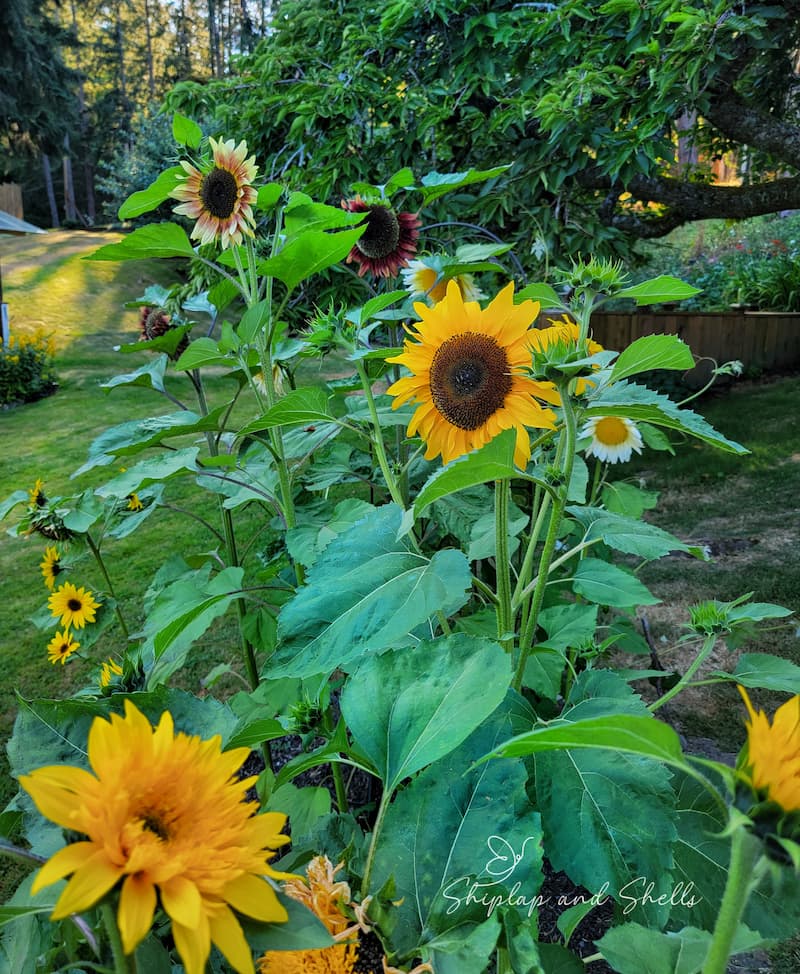
Common Sunflower Problems and Diseases
Sunflowers can face several challenges that may hinder their growth and bloom.
Leggy Growth
One of the most common issues is leggy growth, which occurs when sunflowers are grown in insufficient light or are overcrowded. Ensure they receive at least 6-8 hours of full sun daily and space them adequately to promote strong, upright growth.
Fungal Diseases
Fungal diseases like powdery mildew, rust, and downy mildew can cause leaf yellowing, wilting, and spotting. To minimize these fungal issues, improve air circulation by spacing plants appropriately and avoiding overhead watering.
Powdery mildew appears as white powdery spots on leaves but can be managed with neem oil.
Root Rot
Root rot and verticillium wilt can occur in poorly-draining soils. Plant sunflowers in well-draining soil and rotate crops annually to minimize disease risk.
Nutrient Deficiencies
Nutrient deficiencies may lead to yellowing leaves or stunted growth. A balanced fertilizer or organic compost can replenish essential nutrients and support healthy development.
Sunflower Head Droop
This can occur for various reasons, including overwatering, nutrient imbalance, or natural maturation. While it’s natural for heads to droop when seeds mature, be sure to stake your sunflowers if the droop is due to weak stems or external factors like heavy rain.
Recognizing and addressing these common sunflower problems can help your plants thrive and enjoy their cheerful blooms all season.
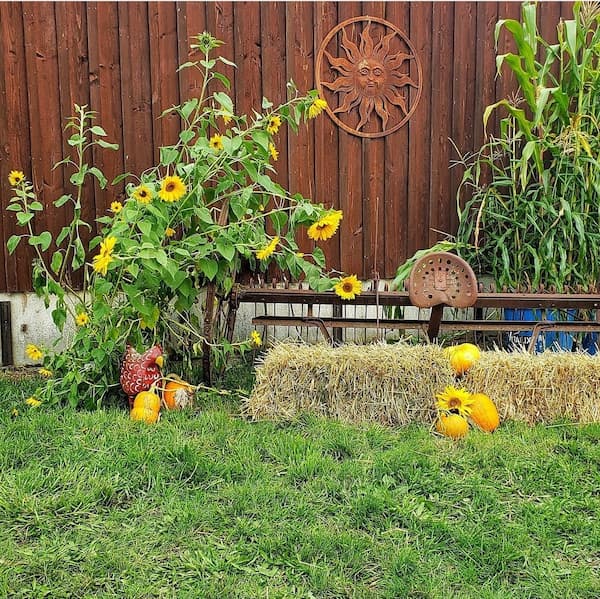
How Do You Keep Sunflowers Blooming All Summer?
A few key gardening techniques are essential to keep sunflowers blooming all summer.
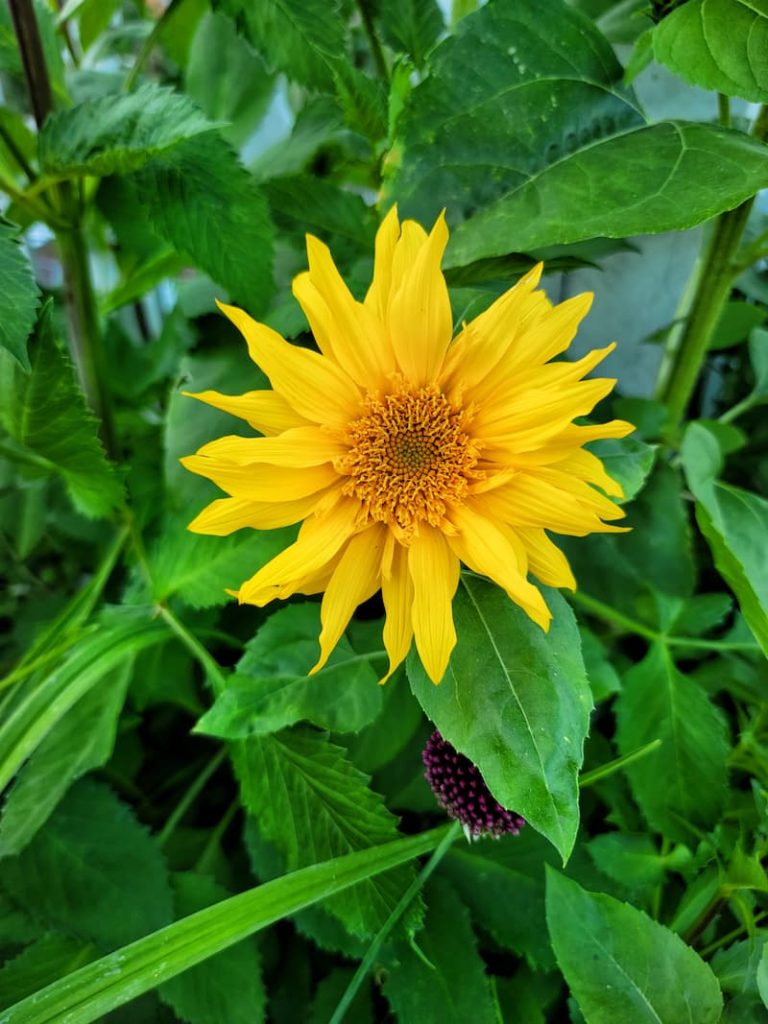
Month-By-Month Sunflower Grow Chart
Month 1: Sowing and Germination (April/May)
Start seeds indoors 4-6 weeks before the last frost date, or sow directly outdoors after the danger of frost has passed. The soil temperature should be around 50-60°F (10-15°C).
TASKS
Month 2: Seedling Stage (May/June)
Transplant seedlings outdoors after the last frost or thin direct-sown seedlings 1-2 feet apart.
TASKS
Month 3: Vegetative Growth (June/July)
Sunflowers will be rapidly growing in height.
TASKS
Month 4: Bud Formation (July/August)
Flower buds will start to form at the top of the stems.
TASKS
Month 5: Blooming Phase (August/September)
The flowers will open their beautiful blooms.
TASKS
Month 6: Seed Maturation (September/October)
Sunflower heads will begin to dry as seeds mature.
Sunflowers reach full maturity in around three months, after which they’re ready to harvest. Their colors start to brown, and the seeds grow heavy and thick and feel loose.
When the plant begins to wane and die, the flower head will also point towards the ground. At this point, cut off the flower heads (roughly one foot below the petals) and hang them in a cool, dry area for a week.
TASKS
Month 7: Harvest and Cleanup (October/November)
Harvest remaining seeds and clean up the garden.
TASKS
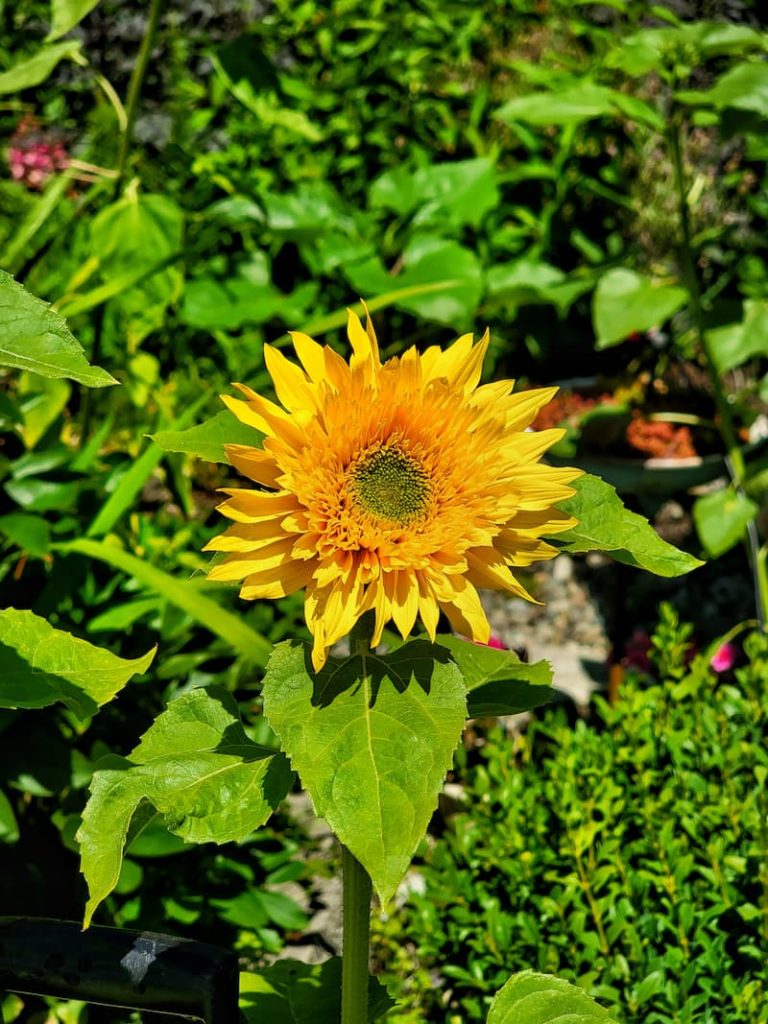
Harvesting Sunflowers and Sunflower Seeds
Harvesting sunflowers and sunflower seeds is the perfect end to the growing season.
Whether you’re gathering sunflower blooms to brighten your home or collecting seeds for snacking, the bird feeder, or next year’s garden, knowing when and how to harvest is key.
As you’re guided through the steps to harvest sunflower seeds at the peak of ripeness, discover the best techniques for cutting and preserving sunflower blooms.
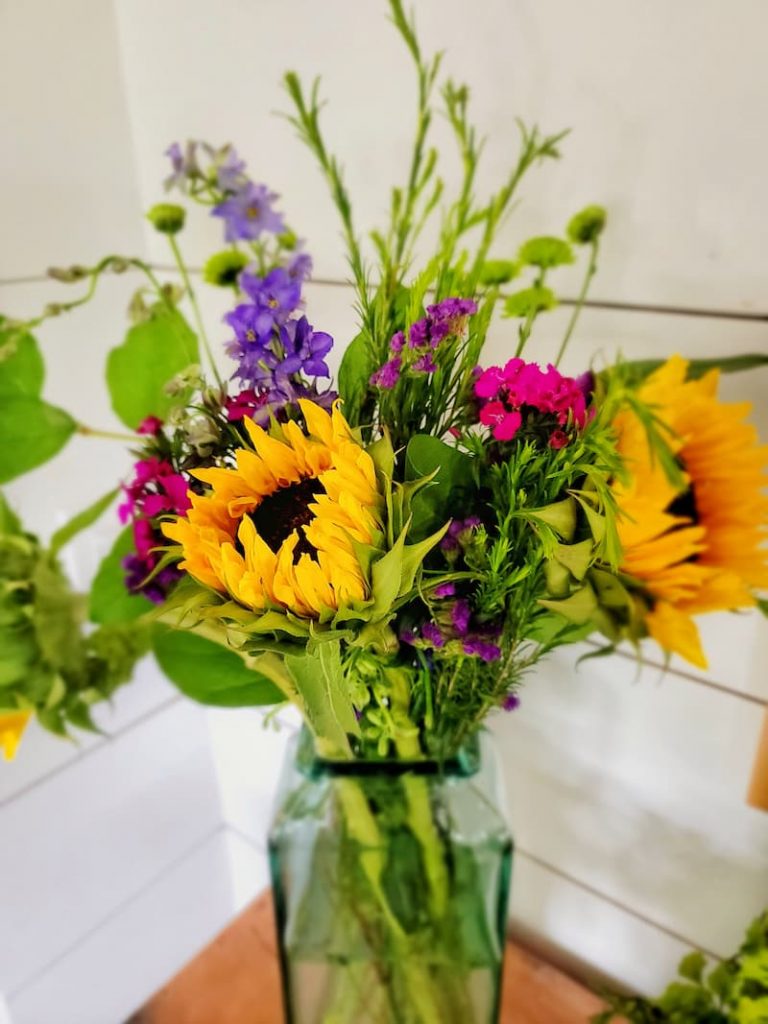
Cutting Sunflowers for Dipslay
Sunflowers make beautiful cut flowers! Here are the steps to cutting flowers to take inside.
- To ensure long-lasting and vibrant blooms, it’s best to cut sunflowers early morning or late evening when temperatures are cooler and the plants are well-hydrated.
- Choose stems with flower buds that have just begun to open or are fully open but still have firm flowers.
- Using clean, sharp shears or a knife, cut the stem at a 45-degree angle, about 12-18 inches long, and immediately place the cut stems in a bucket of water.
- Remove any leaves below the waterline in your vase to prevent rot.
- To extend the sunflowers’ vase life, arrange them in fresh water with flower food and change the water every few days.

Harvesting Sunflower Seeds
Harvesting sunflower seeds requires careful timing to ensure they are fully mature. Let the sunflower heads ripen on the plant. You’ll know they’re ready for harvest when the back of the flower head turns from green to yellow-brown and the seeds become plump and loose.
Cover the heads with a mesh bag or cheesecloth as they dry to protect them from birds and squirrels. Once the seed heads are completely dry, cut them off the plant, leaving about 12 inches of stem for easy handling.
Rub the seeds off the head using your fingers or a brush, or tap the head against a hard surface to dislodge them. Separate any debris, then spread the seeds on a tray to dry for a few days before storing them in an airtight container in a cool, dry place.
If you’re saving seeds for snacking, roast them with salt and oil for a delicious treat, leave them raw for feeding birds, or replant them in the garden next season.
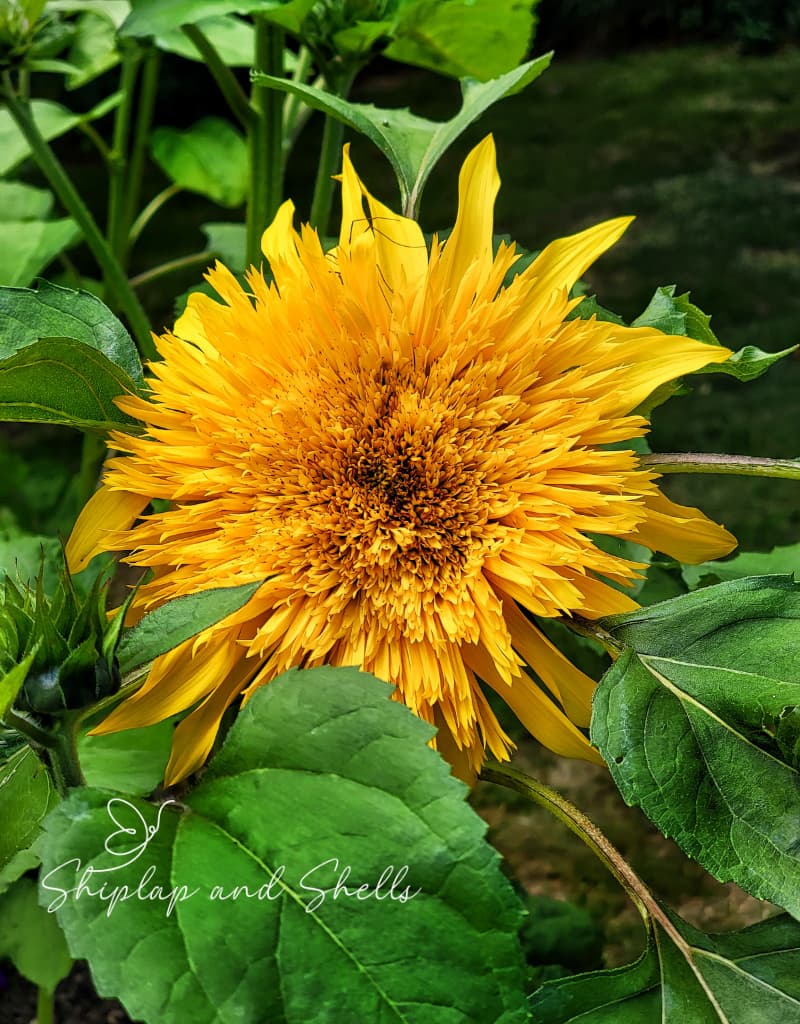
Sunflower Growth Hacks – Do They Work?
Gardeners share tips and tricks for cultivating the perfect sunflower, from unconventional planting methods to DIY fertilizers and creative pest deterrents.
But do these growth hacks work, or are they just gardening myths? Let’s reveal which can help you achieve your best sunflower harvest yet.
Do Coffee Grounds Help Sunflowers Grow Better?
Coffee grounds can help sunflowers grow better when used in moderation.
They contain nitrogen, a nutrient essential for healthy leaf and stem development. Mix coffee grounds into your sunflower care routine and put them into your compost, or sprinkle a thin layer directly onto the soil around your sunflowers. This will gradually release nitrogen and improve soil structure.
However, be careful not to apply too many coffee grounds directly, as their high acidity and fine texture can cause soil compaction or affect the soil’s pH.
For best results, combine coffee grounds with other organic matter, such as compost or mulch, to create a balanced, nutrient-rich environment for your sunflowers.
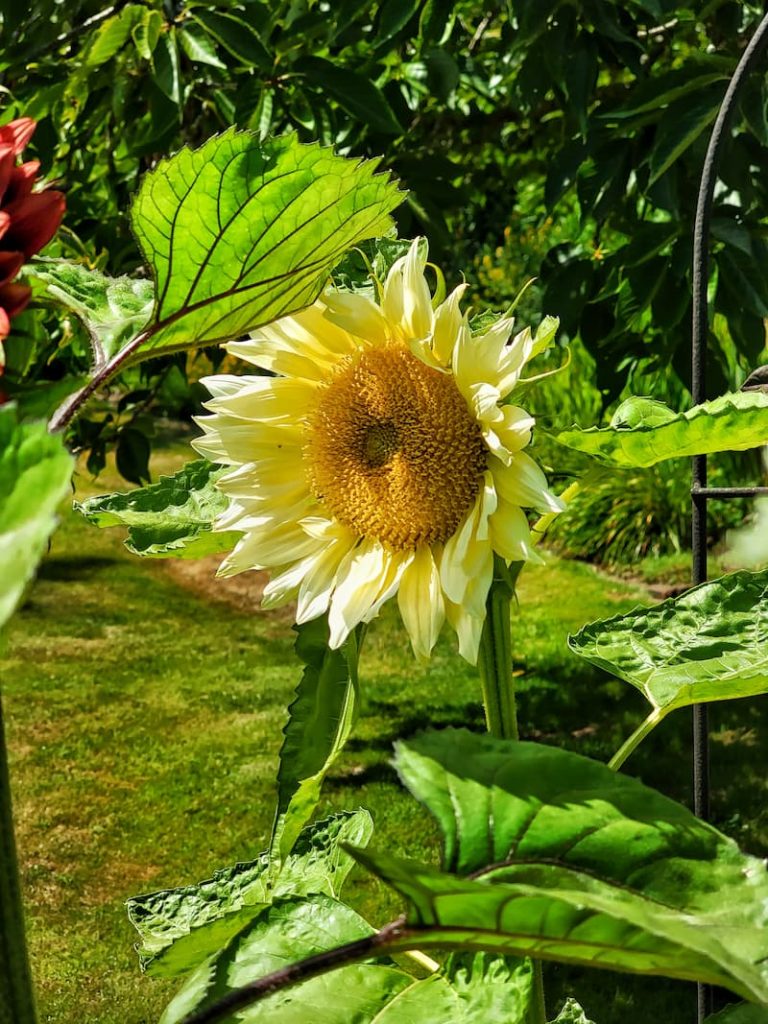
Does Epsom Salt Help Sunflowers Grow?
Epsom salt contains magnesium sulfate and can help sunflowers grow better in certain conditions. Magnesium is an essential nutrient that aids chlorophyll production and supports healthy leaf development, while sulfur promotes enzyme activity and nutrient absorption.
If your soil is deficient in magnesium, using Epsom salt can help improve sunflower growth. To apply, mix 1-2 tablespoons of Epsom salt in a gallon of water and water your sunflowers every 2-4 weeks during the growing season.
Or sprinkle a tablespoon of Epsom salt around the base of each plant and water thoroughly.
It’s important not to over-apply, as excessive magnesium can cause nutrient imbalances. Conduct a soil test beforehand to determine whether your sunflowers would benefit from this supplement.
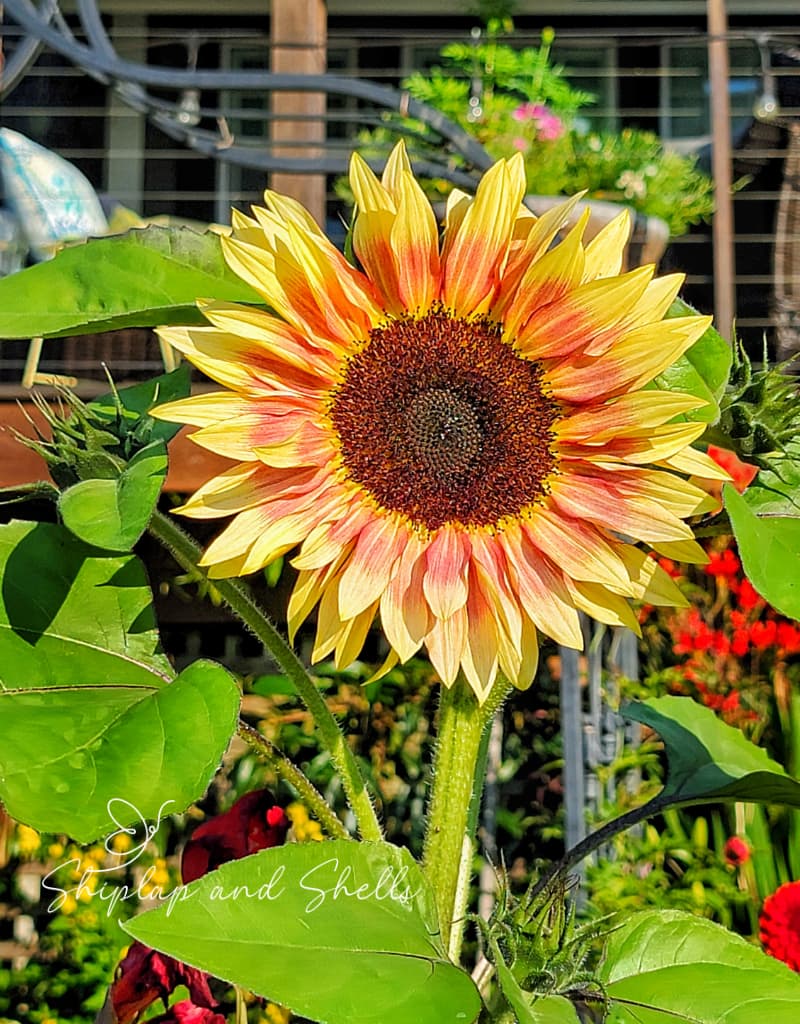
Final Thoughts on Growing and Caring for Sunflowers
Sunflowers are a great addition to any garden with their sunny yellow petals. This annual plant attracts beneficial insects, such as bees and butterflies, and makes stunning cut flowers.
Every step will bring you the most beautiful blooms, from choosing the right varieties and prepping the soil to nurturing sunflowers through staking, watering, and fertilizing.
While challenges like pests, diseases, and leggy growth can arise, careful planning and maintenance will help your sunflowers flourish.
Whether cutting them for display, harvesting seeds for snacking, or enjoying them in the garden, sunflowers offer endless rewards. With the tips and techniques in this guide, you’re ready to grow sunflowers from seed that will thrive and brighten your garden throughout the season.
If you have any questions or additional suggestions, please share them in the comments below. And be sure to share this blog post link with anyone who may find these gardening tips useful.
Until next time,
Happy Gardening!

I’m a self-taught hobby gardener. Everything I share on my blog is my opinion and what has worked for me.
YOU MAY ALSO
Enjoy These Posts
Follow Me for More Inspiration
Shop my Amazon Storefront, LTK sources, and favorite home decor, garden, and lifestyle products. When you purchase from one of my links, I earn a small commission, which helps me continue sharing all the content you expect on my blog.
Be sure to follow me on Pinterest, Instagram, Facebook, TikTok and LIKEtoKNOW.it. Do you like gardening? Join my Facebook Gardening Tips & Tricks group.

